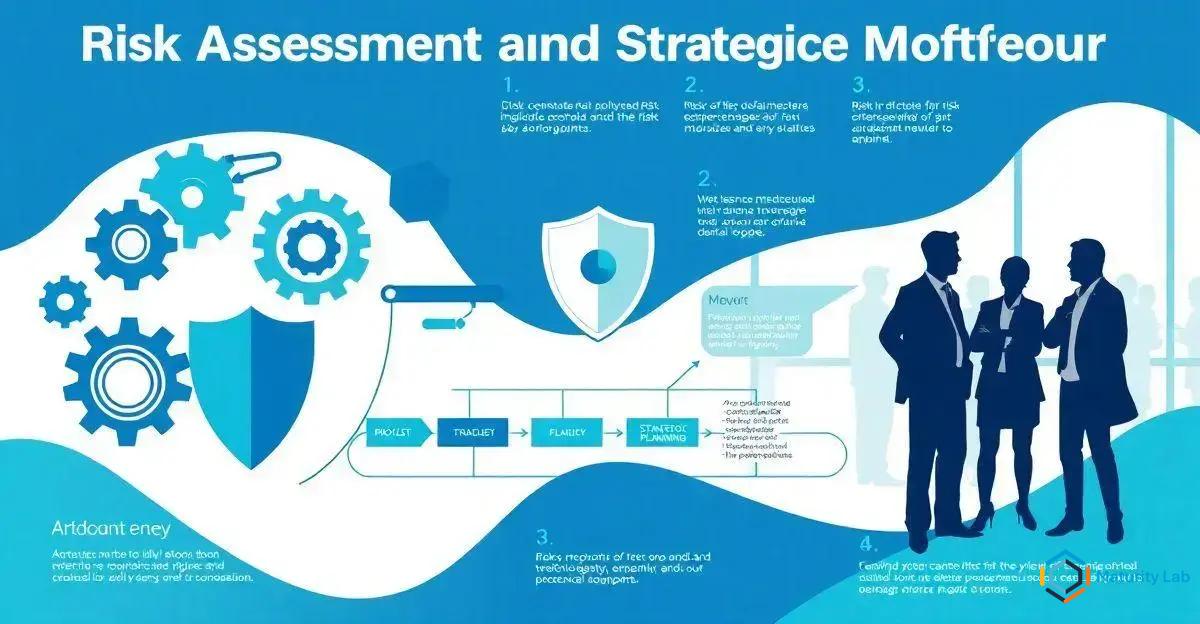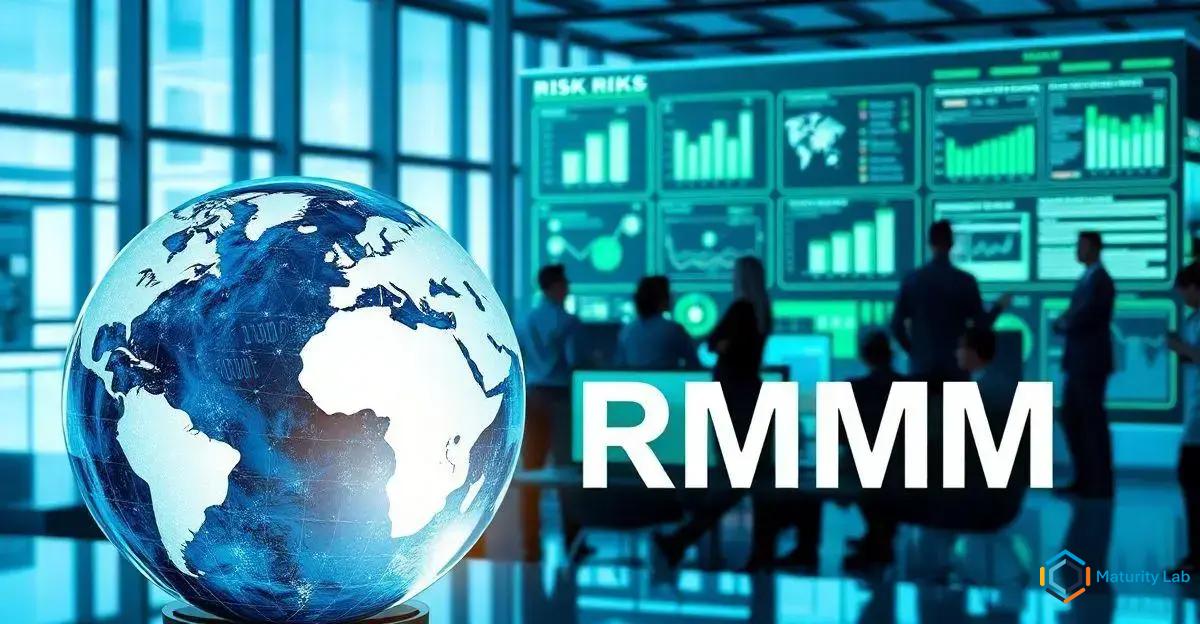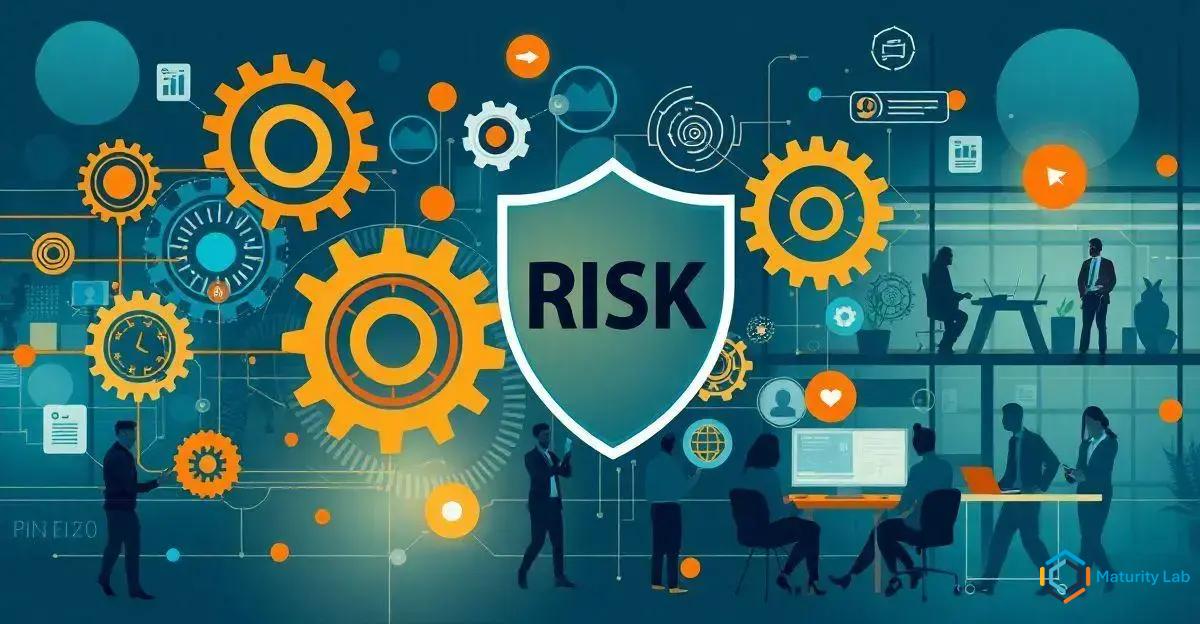The Risk Management Maturity Model (RMMM) is a structured framework that assists organizations in identifying, assessing, and mitigating risks effectively. It encompasses key elements such as risk identification, analysis, evaluation, and communication, along with strategic mitigation techniques like avoidance, reduction, transfer, acceptance, and sharing. To implement RMMM, organizations must evaluate their current maturity levels, create a risk management framework, involve stakeholders, integrate risk management with strategic planning, and continuously enhance their practices. By adopting RMMM, organizations can improve their resilience and competitiveness, enabling them to manage uncertainties and achieve sustainable growth.
In today’s dynamic business environment, understanding and managing risks is crucial for organizational success. The Risk Management Maturity Model (RMMM) offers a structured approach to risk assessment and strategic mitigation, ensuring that businesses can navigate uncertainties effectively. By leveraging RMMM, organizations can systematically identify, evaluate, and address potential risks, thereby enhancing their resilience and sustainability. This article delves into the core aspects of RMMM, exploring its key components and strategic mitigation techniques, and provides practical insights on implementing RMMM within your organization.
Understanding RMMM and Its Importance

The Risk Management Maturity Model (RMMM) is a comprehensive framework designed to help organizations systematically identify, assess, and mitigate risks.
It provides a structured approach to risk management, ensuring that all potential threats are addressed proactively. Understanding RMMM is crucial for any organization aiming to enhance its risk management capabilities and achieve long-term sustainability.
RMMM is built on the premise that risk management should be an integral part of an organization’s strategic planning and operational processes. By adopting RMMM, organizations can move beyond reactive measures and develop a proactive risk management culture.
This shift not only helps in identifying risks early but also in devising effective mitigation strategies that align with the organization’s objectives.
Continuous Improvement
One of the key aspects of RMMM is its focus on continuous improvement. The model encourages organizations to regularly review and update their risk management practices, ensuring they remain relevant and effective in the face of evolving threats.
This iterative process helps organizations stay ahead of potential risks and adapt to changing business environments.
Moreover, RMMM emphasizes the importance of stakeholder involvement in risk management. By engaging various stakeholders, including employees, customers, suppliers, and regulators, organizations can gain a comprehensive understanding of the risks they face.
This collaborative approach ensures that risk management strategies are well-informed and robust.
In essence, RMMM provides a roadmap for organizations to develop a mature risk management framework. It helps in building a resilient organization that can withstand uncertainties and capitalize on opportunities.
By understanding and implementing RMMM, organizations can not only protect their assets but also enhance their overall performance and competitiveness in the market.
Key Components of Risk Assessment in RMMM

Risk assessment is a fundamental component of the Risk Management Maturity Model (RMMM), providing a systematic approach to identifying, analyzing, and prioritizing risks. The key components of risk assessment in RMMM are designed to ensure a thorough understanding of potential threats and their impact on the organization.
1. Risk Identification: The first step in the risk assessment process is identifying potential risks that could affect the organization. This involves a comprehensive review of internal and external factors, including market trends, regulatory changes, technological advancements, and operational vulnerabilities. Effective risk identification requires input from various stakeholders to capture a wide range of perspectives and insights.
2. Risk Analysis: Once risks are identified, the next step is to analyze their potential impact and likelihood. This involves evaluating the severity of each risk and its probability of occurrence. Quantitative methods, such as statistical analysis and modeling, can be used to assess risks objectively. Qualitative techniques, such as expert judgment and scenario analysis, also play a crucial role in understanding the nuances of each risk.
3. Risk Evaluation: After analyzing the risks, they need to be evaluated to determine their significance and prioritize them accordingly. This involves comparing the assessed risks against the organization’s risk tolerance and appetite. Risks that exceed acceptable levels require immediate attention, while those within acceptable limits can be monitored and managed over time. Risk evaluation helps in allocating resources effectively to address the most critical threats.
4. Risk Documentation: Proper documentation of the risk assessment process is essential for transparency and accountability. This includes recording identified risks, their analysis, evaluation results, and the rationale behind prioritization decisions. Documenting risks ensures that all stakeholders have a clear understanding of the risk landscape and can refer to this information for future assessments and decision-making.
5. Risk Communication: Effective communication of risk assessment findings is vital for informed decision-making. This involves sharing the results with relevant stakeholders, including senior management, employees, and external partners. Clear and concise communication helps in building awareness and understanding of risks, fostering a risk-aware culture within the organization.
By incorporating these key components, RMMM ensures a comprehensive and systematic approach to risk assessment. This not only helps in identifying and prioritizing risks but also in developing effective mitigation strategies to safeguard the organization’s interests and achieve its strategic objectives.
Strategic Mitigation Techniques in RMMM

Implementing the Risk Management Maturity Model (RMMM) in an organization involves a structured approach to embedding risk management practices into the organizational culture and processes. This ensures that risk management becomes an integral part of decision-making and strategic planning. Here are the key steps to successfully implement RMMM in your organization:
1. Assessment of Current Maturity Level: The first step in implementing RMMM is to assess the organization’s current risk management maturity level. This involves evaluating existing risk management practices, policies, and procedures. Organizations can use maturity assessment tools and frameworks to identify gaps and areas for improvement. Understanding the current maturity level provides a baseline for measuring progress and setting realistic goals.
2. Development of a Risk Management Framework: Based on the assessment results, organizations should develop a comprehensive risk management framework that aligns with RMMM principles. This framework should outline the risk management process, roles and responsibilities, and governance structures. It should also include policies and procedures for risk identification, assessment, mitigation, and monitoring. A well-defined framework ensures consistency and standardization in risk management practices across the organization.
3. Stakeholder Engagement and Training: Effective implementation of RMMM requires active engagement and collaboration with stakeholders at all levels. This includes senior management, employees, customers, suppliers, and regulators. Organizations should conduct training and awareness programs to educate stakeholders about the importance of risk management and their roles in the process. Building a risk-aware culture is essential for the successful adoption of RMMM.
4. Integration with Strategic Planning and Operations: Risk management should be integrated into the organization’s strategic planning and operational processes. This involves incorporating risk assessments into strategic decision-making, project planning, and performance management. By aligning risk management with organizational objectives, organizations can ensure that risks are considered in all critical decisions and actions.
5. Implementation of Risk Mitigation Strategies: Once the risk management framework is in place, organizations should implement appropriate risk mitigation strategies. This includes risk avoidance, reduction, transfer, acceptance, and sharing, as discussed in the previous section. Organizations should prioritize risks based on their impact and likelihood and allocate resources accordingly to address the most critical threats.
6. Continuous Monitoring and Improvement: Implementing RMMM is an ongoing process that requires continuous monitoring and improvement. Organizations should regularly review and update their risk management practices to ensure they remain effective and relevant. This involves conducting periodic risk assessments, monitoring key risk indicators, and evaluating the effectiveness of mitigation strategies. Continuous improvement helps organizations stay ahead of emerging risks and adapt to changing business environments.
By following these steps, organizations can successfully implement RMMM and develop a mature risk management framework. This not only enhances their ability to manage risks but also strengthens their overall resilience and competitiveness in the market.
Strategic mitigation techniques are essential in the Risk Management Maturity Model (RMMM) to address identified risks effectively. These techniques ensure that organizations can not only manage but also minimize the impact of risks on their operations and strategic objectives. Here are some of the key strategic mitigation techniques employed in RMMM:
1. Risk Avoidance: This technique involves altering plans or processes to eliminate the risk entirely. By avoiding high-risk activities or decisions, organizations can prevent potential threats from materializing. For instance, a company might choose not to enter a volatile market to avoid geopolitical risks.
2. Risk Reduction: Risk reduction focuses on minimizing the likelihood or impact of a risk. This can be achieved through various measures such as implementing robust internal controls, enhancing security protocols, or adopting new technologies. For example, a financial institution might invest in advanced cybersecurity systems to reduce the risk of data breaches.
3. Risk Transfer: Transferring risk involves shifting the risk to a third party, typically through insurance or outsourcing. This technique is particularly useful for risks that are difficult to manage internally. For instance, a company might purchase insurance to cover potential losses from natural disasters or outsource IT services to a specialized provider to mitigate operational risks.
4. Risk Acceptance: In some cases, organizations may decide to accept the risk, especially if the cost of mitigation exceeds the potential impact. This approach requires a thorough understanding of the risk and a clear rationale for acceptance. For example, a company might accept the risk of minor fluctuations in currency exchange rates if the impact on overall profitability is negligible.
5. Risk Sharing: Risk sharing involves distributing the risk among multiple parties, such as joint ventures or partnerships. By sharing the risk, organizations can reduce their individual exposure while still pursuing strategic opportunities. For instance, a construction company might enter into a joint venture with another firm to share the risks associated with a large infrastructure project.
6. Risk Monitoring and Review: Continuous monitoring and review of risks are crucial for effective risk management. This involves regularly assessing the effectiveness of mitigation strategies and making necessary adjustments. By keeping a close watch on the risk landscape, organizations can respond promptly to emerging threats and ensure their mitigation efforts remain relevant.
By employing these strategic mitigation techniques, RMMM helps organizations develop a proactive and resilient approach to risk management. These techniques not only safeguard the organization against potential threats but also enable it to capitalize on opportunities with confidence. Implementing these strategies effectively requires a deep understanding of the organization’s risk profile and a commitment to continuous improvement.
Implementing RMMM in Your Organization

Implementing the Risk Management Maturity Model (RMMM) in an organization involves a structured approach to embedding risk management practices into the organizational culture and processes. This ensures that risk management becomes an integral part of decision-making and strategic planning.
Here are the key steps to successfully implement RMMM in your organization:
1. Assessment of Current Maturity Level: The first step in implementing RMMM is to assess the organization’s current risk management maturity level. This involves evaluating existing risk management practices, policies, and procedures. Organizations can use maturity assessment tools and frameworks to identify gaps and areas for improvement. Understanding the current maturity level provides a baseline for measuring progress and setting realistic goals.
2. Development of a Risk Management Framework: Based on the assessment results, organizations should develop a comprehensive risk management framework that aligns with RMMM principles. This framework should outline the risk management process, roles and responsibilities, and governance structures. It should also include policies and procedures for risk identification, assessment, mitigation, and monitoring. A well-defined framework ensures consistency and standardization in risk management practices across the organization.
3. Stakeholder Engagement and Training: Effective implementation of RMMM requires active engagement and collaboration with stakeholders at all levels. This includes senior management, employees, customers, suppliers, and regulators. Organizations should conduct training and awareness programs to educate stakeholders about the importance of risk management and their roles in the process. Building a risk-aware culture is essential for the successful adoption of RMMM.
4. Integration with Strategic Planning and Operations: Risk management should be integrated into the organization’s strategic planning and operational processes. This involves incorporating risk assessments into strategic decision-making, project planning, and performance management. By aligning risk management with organizational objectives, organizations can ensure that risks are considered in all critical decisions and actions.
5. Implementation of Risk Mitigation Strategies: Once the risk management framework is in place, organizations should implement appropriate risk mitigation strategies. This includes risk avoidance, reduction, transfer, acceptance, and sharing, as discussed in the previous section. Organizations should prioritize risks based on their impact and likelihood and allocate resources accordingly to address the most critical threats.
6. Continuous Monitoring and Improvement: Implementing RMMM is an ongoing process that requires continuous monitoring and improvement. Organizations should regularly review and update their risk management practices to ensure they remain effective and relevant. This involves conducting periodic risk assessments, monitoring key risk indicators, and evaluating the effectiveness of mitigation strategies. Continuous improvement helps organizations stay ahead of emerging risks and adapt to changing business environments.
By following these steps, organizations can successfully implement RMMM and develop a mature risk management framework. This not only enhances their ability to manage risks but also strengthens their overall resilience and competitiveness in the market.
In conclusion, the Risk Management Maturity Model (RMMM) offers a robust framework for organizations to systematically identify, assess, and mitigate risks.
By understanding the importance of RMMM and its key components, organizations can develop a proactive risk management culture that enhances their resilience and strategic decision-making capabilities.
Strategic Mitigation Techniques
The strategic mitigation techniques outlined in RMMM, such as risk avoidance, reduction, transfer, acceptance, and sharing, provide a comprehensive approach to managing potential threats.
Implementing RMMM involves a structured process of assessing current maturity levels, developing a risk management framework, engaging stakeholders, integrating risk management with strategic planning, and continuously monitoring and improving practices.
By adopting RMMM, organizations can not only safeguard their assets and operations but also position themselves for long-term success and competitiveness in an ever-evolving business landscape.
Ultimately, RMMM empowers organizations to navigate uncertainties with confidence, ensuring sustainable growth and stability.
Frequently Asked Questions about RMMM, Risk Assessment, and Strategic Mitigation
What is the Risk Management Maturity Model (RMMM)?
The Risk Management Maturity Model (RMMM) is a comprehensive framework designed to help organizations systematically identify, assess, and mitigate risks. It provides a structured approach to risk management, ensuring that all potential threats are addressed proactively.
Why is RMMM important for organizations?
RMMM is crucial for organizations as it helps them move beyond reactive measures and develop a proactive risk management culture. This shift enables early identification of risks and effective mitigation strategies, aligning with organizational objectives and enhancing resilience.
What are the key components of risk assessment in RMMM?
The key components of risk assessment in RMMM include risk identification, risk analysis, risk evaluation, risk documentation, and risk communication. These components ensure a thorough understanding of potential threats and their impact on the organization.
What strategic mitigation techniques are used in RMMM?
Strategic mitigation techniques in RMMM include risk avoidance, risk reduction, risk transfer, risk acceptance, risk sharing, and continuous risk monitoring and review. These techniques help organizations manage and minimize the impact of risks effectively.
How can an organization implement RMMM?
Implementing RMMM involves assessing the current maturity level, developing a risk management framework, engaging stakeholders, integrating risk management with strategic planning, implementing risk mitigation strategies, and continuously monitoring and improving practices.
What are the benefits of adopting RMMM?
Adopting RMMM enhances an organization’s ability to manage risks, strengthens overall resilience, and improves competitiveness. It empowers organizations to navigate uncertainties confidently, ensuring sustainable growth and stability.

